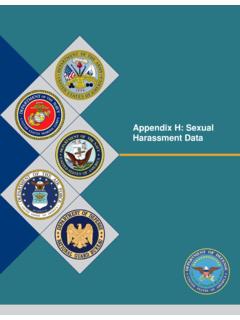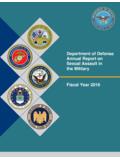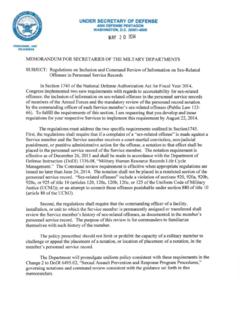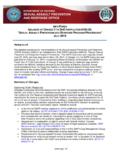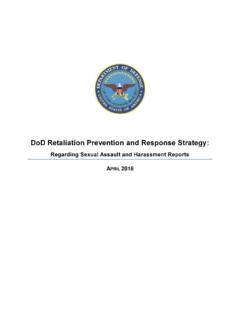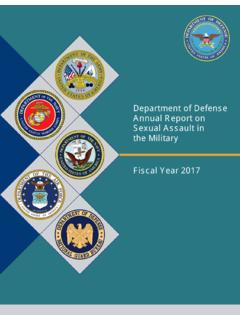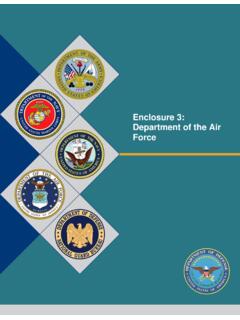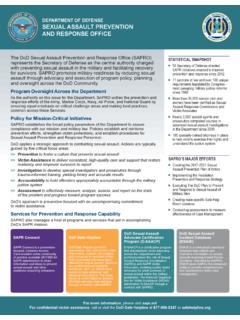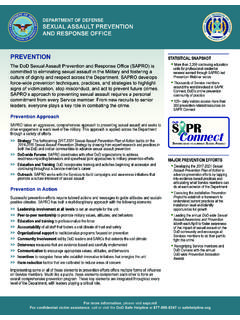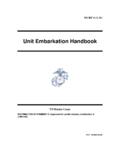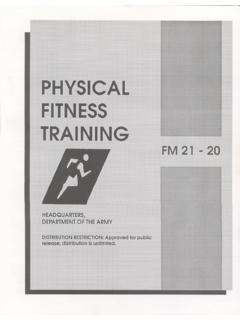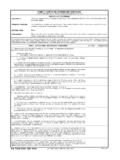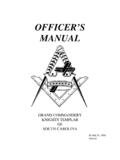Transcription of Commanders’ Guide on Selecting and …
1 1 Commanders Guide on Selecting and recommending SARCS and SAPR VAs Overview The Department of Defense (DoD) Sexual Assault Advocate Certification Program (D-SAACP) recognizes the critical support Sexual Assault Response Coordinators (SARCs) and Sexual Assault Prevention and Response (SAPR) Victim Advocates (VAs) provide to victims of sexual assault. Through D-SAACP, SARCs and SAPR VAs receive nationally recognized certification validating their training and commitment to upholding the highest standards for victim care and privacy. More information on this program can be found at An essential part of the D-SAACP Application Package (DD Form 2950)
2 Are two Letters of Recommendation one from the first person in the applicant s chain of command and one from the applicant s senior commanding Prior to completing the Letter of Recommendation, commanders must speak with the D-SAACP applicant and confirm that a background check has been performed and that they are confident in the applicant s moral character, professional abilities, understanding of and willingness to perform the duties required, along with observing a commitment to maintain the victim s privacy. Commanders should follow Service-specific guidelines when interviewing SARCs and SAPR VAs and utilize DD Form 2909, Victim Advocate and Supervisor Statement of Understanding.
3 Commanders should be confident in their selection of SARCs and SAPR VAs. This Guide provides resources and information a commander might find helpful when preparing to select and recommend a SARC and/or SAPR VA. Enclosed are: The DoD Victim Advocate Competencies Framework which represents the knowledge, skills, and attitudes SARCs and SAPR VAs should possess; Suggested questions for guiding the selection of SARCs/SAPR VAs; Special considerations when Selecting SARCs/SAPR VAs; and Common myths and facts about sexual assault. 1 IAW DD 2950 s Instructions on page 1, the applicant s recommendation letter from the first person in the chain of command must be from an E-7 or higher, 0-3 or higher, or GS-9 or higher.
4 The Senior Commanding Officer must be an 0-6 or higher, or GS-15 or higher. 2 Elements of Sexual Assault Response Background In 2012, the National Organization for Victim Assistance (NOVA) developed four critical elements of sexual assault response that included crisis intervention, recovery and investigation, command decision-making and action, and reintegration. Collectively, these elements adhere to a national accreditation framework as prescribed by the 2012 National Defense Authorization Act (NDAA) and served as the basis for the coordinated development of SARC and SAPR VA Core Competencies.
5 Four Elements of Sexual Assault Response Immediate efforts to intervene, assess, and reduce the severity of a crisis and address victims' urgent needs Crisis Intervention Period of time when victims experience treatment ( medical care, counseling, chaplain support) and criminal investigation procedures (for Unrestricted Reports) Recovery & Investigation Sequence of events and interactions from when commanders choose to pursue disciplinary action (if they choose to do so) through case resolution Command Decision Making & Action Process in which victims focus on rebuilding their lives Reintegration 3 SARC and SAPR Victim Assistance Core Competencies These competencies apply to the full range of sexual assault prevention, case management, victim advocacy and sexual assault response duties of SARCs and SAPR VAs.
6 In some cases, SARCs and SAPR VAs may need to demonstrate multiple competencies simultaneously. Some competencies, particularly those relating to investigative and administrative processes, will not apply when the SARC or SAPR VA is responding to a Restricted Report. Overarching SARC and SAPR VA Core Competencies Overarching core competencies are those competencies relevant across the spectrum of SAPR prevention, training and education, and response to sexual assault. They include successfully applying and managing the SAPR program to aid victims of sexual assault, demonstrating awareness of the impact of sexual assault, communicating effectively, and upholding the highest of ethical standards.
7 They also include involving command leadership to make positive impacts for individual victims as well as at the command level, active participation in Case Management Group (CMG) meetings, and assessing the command environment to assist leadership manage and mitigate trends of sexual assault. SARCs and SAPR VAs are accountable to provide awareness of the SAPR program to victims in critical areas such as policy and procedures, command personnel roles and responsibilities, and the investigative process. Critical advocacy skills include the impact of trauma, victimization/re-victimization, and the potential psychological consequences from a sexual assault.
8 Effective communication techniques recognize and understand basic principles of communication, including verbal, non-verbal, and cultural variation. Lastly, ethical standards as solidified in the DoD SARC/VA Code of Professional Ethics provide the cohesive bond to ensure professional delivery of victim-centric response, programs and services. Collectively, these core competencies ensure a seamless and integrated SAPR program approach to prevention, training, and education, and overall response to sexual assault. Prevention, Education, and Training Core Competencies The goal of prevention, education, and training is to deliver consistent and effective prevention methods and training programs.
9 Sustained leader emphasis by Commanders and first line supervisors is critical to this effort, as they are central in establishing the climate of dignity, respect, sensitivity, and environmental expectations that can reduce and eliminate this crime. SARCs and SAPR VAs aggressively seek to identify prevention strategies and behaviors that may reduce sexual assaults. While SAPR training and education focuses primarily on the overall force, it also seeks improved professionalization of SARCs and SAPR VAs, as well as first responders and the general public. Together, these core competencies create an atmosphere where the cultural imperatives of mutual respect and trust, professional values, and team commitment are reinforced to create an environment where sexual assault is not tolerated, condoned, or ignored.
10 Response to Sexual Assault SARC and SAPR VA Core Competencies The sexual assault core competencies include responding to victim reports and managing crisis effectively and coordinating services and advocacy for victims. These competencies intersect at various points across the elements of sexual assault response. The overall goal for SARCs and SAPR VAs is to deliver effective victim support, response, and reporting options, so that we instill confidence and trust, strengthen resilience, and inspire victims to report sexual assaults, either restricted or unrestricted.
